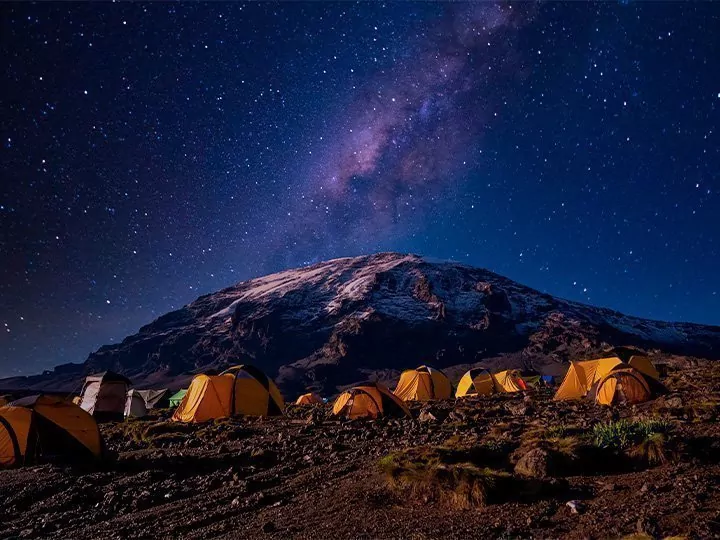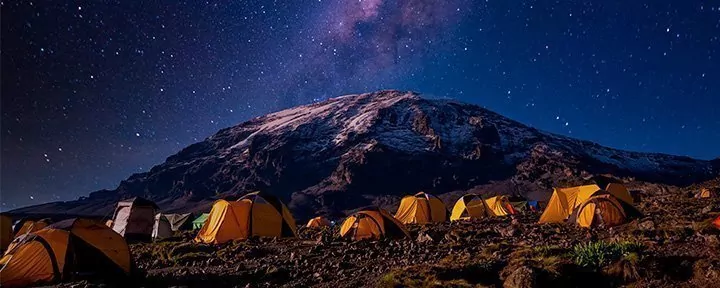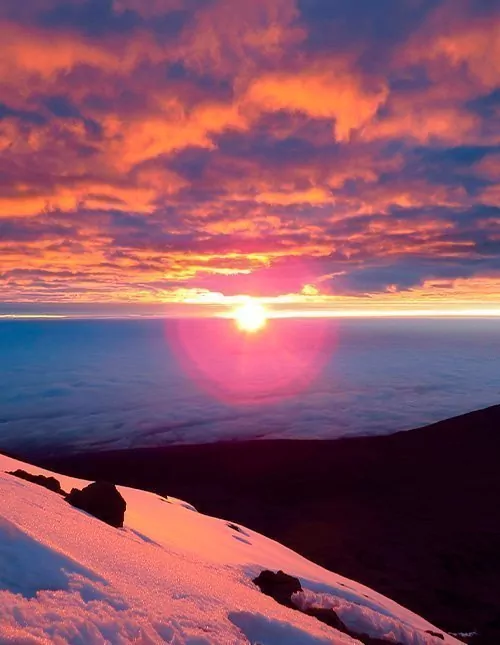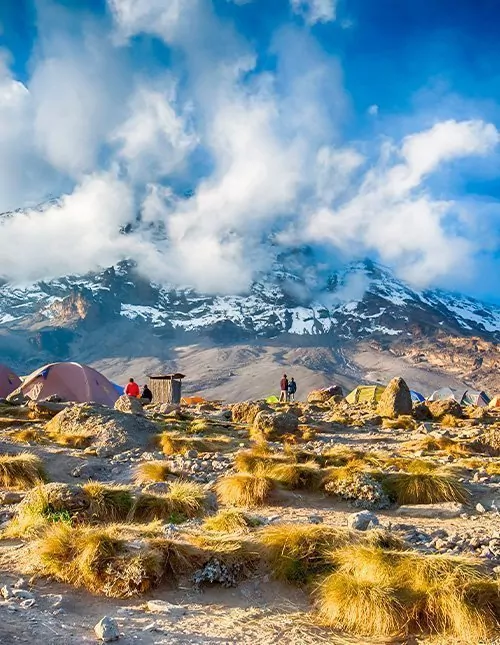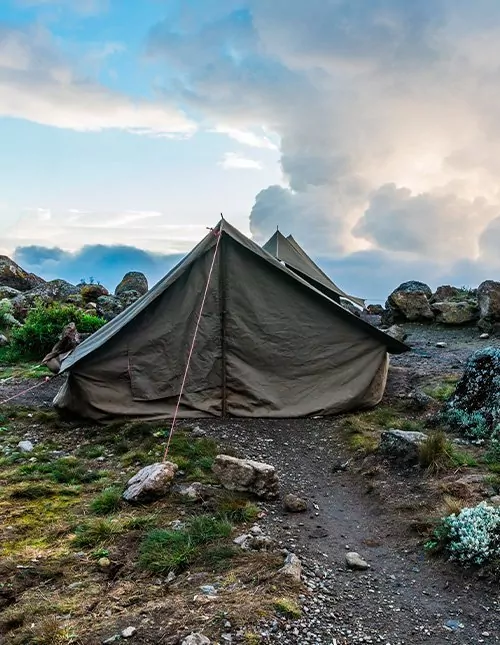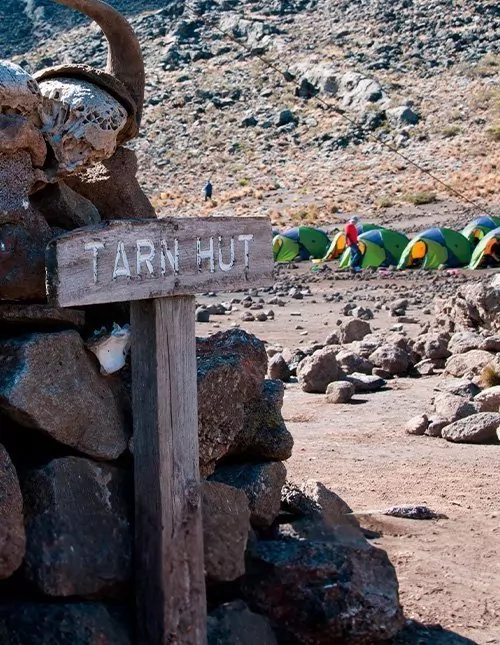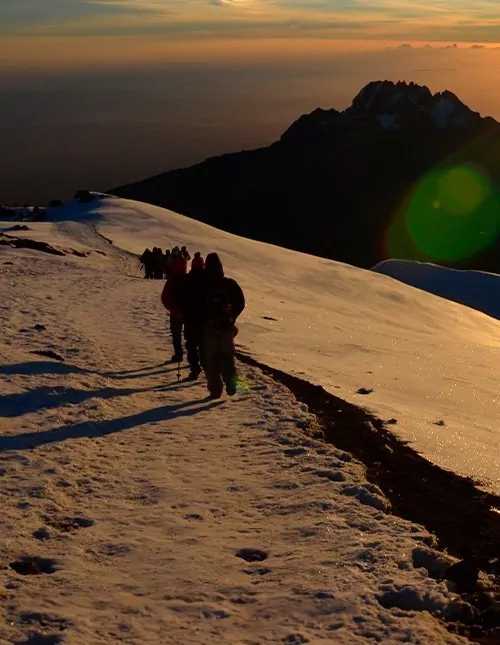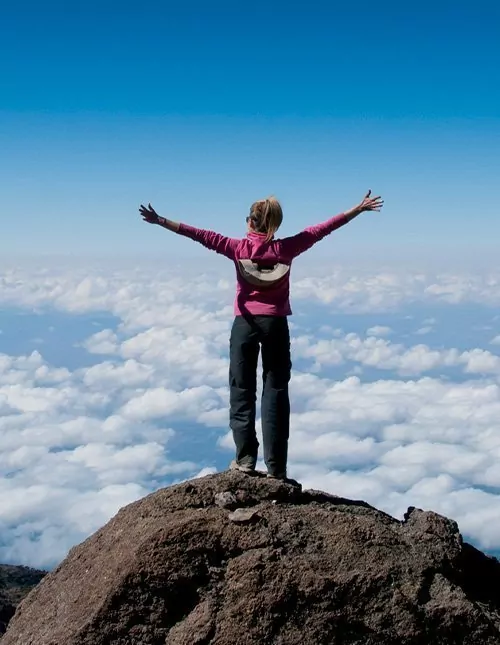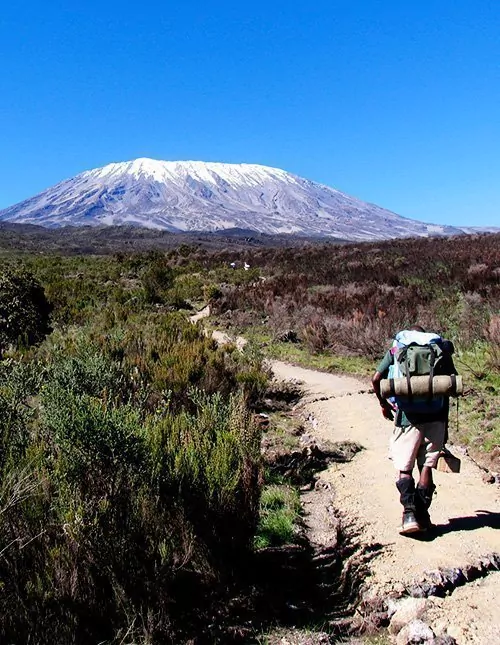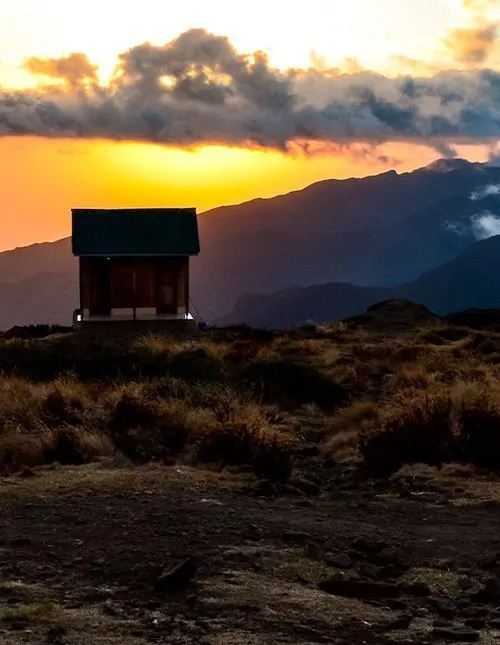Trekking on Kilimanjaro
Go on a mt Kilimanjaro trek and climb the beautiful mountain via one of our five different routes, each of which promises a wonderful and challenging adventure.
All our tours to Kilimanjaro can be rounded off with a safari holiday in Tanzania, a beach holiday in Zanzibar or a combination of safari and Zanzibar.
Below you can read more about mount Kilimanjaro and our different options to climb Africa’s highest mountain.
Kilimanjaro – the world’s highest free-standing mountain
When you fly to East Africa – whatever airport you’re heading for – and you arrive in daylight, you can see Kilimanjaro’s snowy peak poking through the clouds, high in the sky. And when you land at Kilimanjaro airport, you can already experience an incomparable view of the iconic mountain, towering majestically over the East African plateau.
Africa’s highest mountain
Located in Tanzania, near the border with Kenya, Kilimanjaro is the world’s tallest free-standing mountain.
It rises 4,065 metres above the plateau, which is located 1,830 metres above sea level. With a total height of 5,895 metres above sea level (AMSL), Kilimanjaro can also call itself Africa’s highest mountain.
The mountain consists of three extinct volcanoes: Kibo, with the highest point Uhuru at 5,895 AMSL, Mawenzi located 5,149 AMSL, and Shira located at 3,962 AMSL.
The end destination of all our tours is Kilimanjaro’s highest point, Uhuru Peak.
Perhaps the world’s most beautiful mountain
Kilimanjaro is, with good reason, one of the world’s most iconic mountains.
The mountain has a wonderfully beautiful conical shape, and the contrast between the snow-capped peak and its location near the tropical equator is magical.
You can stand on the savannah and see elephants and zebras against a cloudless blue sky, with Kilimanjaro’s grey-brown volcano and snow-capped peak in the background.
Depending on the season, the landscape is dressed in green or golden brown, and Kilimanjaro can be swaddled in clouds or the volcano’s conical shape and snow-capped peak can be in full view. So the seasons and days are every bit as diverse on Kilimanjaro as on other mountains.
Climbing Kilimanjaro
Kilimanjaro has been attracting adventurous climbers for more than a century. The first attempt to reach the summit was made in the late 19th century, and back then there were no set routes.
Today there are several, and at Afrika-safari.dk, you can reach the summit via five different routes.
Kilimanjaro routes
We offer five different trekking routes to the top of Kilimanjaro. The goal of all the routes is Uhuru Peak, the highest point on Kilimanjaro, which is 5,895 metres above sea level.
However, the routes differ in their ease of climbing the mountain, in length and in the number of days that they take to complete.
Below you can read about the main differences between routes.
- Two of the routes set out from the south: Machame and Marangu
- Two of the routes set out from the west: Lemosho and Shira
- 1 route starts in the north: Rongai
The Machame Route – also known as the Whiskey Route
The Machame Route starts from the south and is considered to be one of the most scenic routes. Machame has a high success rate, especially if you opt for an acclimatisation day and so spend six nights on the trek.
The route’s other name, the “Whiskey Route”, is believed to stem from the fact the route to the top is climbed at a leisurely pace – just like when you are enjoying a good whiskey.
The descent is via the Mweka Route.
The Marangu Route – also known as the Coca Cola Route
The Marangu Route is the easiest and shortest route to Kilimanjaro’s peak, making it extremely popular.
Although the route is considered to be the easiest, Marangu generally has the lowest success rate due to the relatively short time you have to reach the summit on many tours. With this in mind, Afrika-safari.dk has built in an acclimatisation day, to increase the chances of reaching the top.
Marangu is the only route where you sleep in cabins rather than tents.
The route is also known as “The Coca Cola Route”, because climbers can buy soft drinks and snacks along the way. Marangu is considered to be the least scenic route, as the same route is followed for both the ascent and the descent.
The Rongai Route
The Rongai Route sets out from the north-east, near the border with Kenya. The route is more scenic than Marangu and easier than Machame.
During the first four days, the route takes you through stunning, unspoiled nature, and offers you a good chance of spotting some of Africa’s iconic animals. There are less people on the Rongai Route than the other routes. The route is flatter for a longer, and the success rate is very high.
The north side of Kilimanjaro is generally drier than the south side, making Rongai the preferred route during the wet months. The Rongai Route gives you a lovely glimpse of the Kilimanjaro peak more often than from the south.
The descent is via the Marangu Route.
The Lemosho Route
The Lemosho Route is one of the longest routes, and the one with the highest success rate. This is due to possibility of acclimatisation that it offers.
The Lemosho Route is also considered to be the most scenic as it not only takes you through relatively unspoiled nature, but it also gives you a unique view of the dramatic gorges on Kilimanjaro’s west side.
On the first couple of days, trekkers can spot larger animals such as antelopes, buffaloes and, occasionally, elephants. You trek across the Shira Plateau, which is one of the world’s largest high plain plateaus.
The descent is via the Mweka Route.
The Shira Route
The Shira Route is almost identical to Lemosho, except for one important thing: the starting point is considerably higher up. Due to the harder and more demanding start, the success rate on the Shira Route is also lower.
The starting point of the Shira Route is also so high that the likelihood of spotting animals is low. On the other hand, you will encounter a very diverse landscape, passing rainforest, moorland and alpine desert.
The descent is via the Mweka Route.
Avoid altitude sickness
Although Kilimanjaro is technically not difficult to climb, there is a risk of altitude sickness if your body is not given time to get used to the altitude difference that you experience on the ascent.
Hiking pace and acclimatisation are both important elements in avoiding altitude sickness:
Hiking pace
Pole-pole. A phrase you will hear a lot from the guides and porters during the ascent of Kilimanjaro.
It is Swahili and means “take it easy”. And when you climb Kilimanjaro, it is important to take it easy and go slow, as this helps to ensure that you have the strength you need to make it all the way to the top.
Acclimatisation
Acclimatisation is another important factor in reaching the summit. Acclimatisation is about slowly letting your body get used to the lower oxygen content in the air, the higher you go.
In practice, this means climbing many metres during the day and then descending to the same starting point or thereabouts in the afternoon. This is known as the “climb high, sleep low” principle. This way, your body continuously gets used to the heights, increasing your chances of reaching the summit.
Many of our tours include an extra acclimatisation day. It is also possible to select an extra day for acclimatisation when you book.
Porters, accommodation and meals
On our tours, professional porters take care of all your equipment, tents included. Every day, they pack up the tents and set off for the next camp ahead of the group, where they put them up again.
All overnight stays are in tents, except on the Marangu Route, where you sleep in primitive dorm-like huts.
Chefs prepare the food, and every morning you start with a good breakfast to give you the fuel you need for a day of hiking. Depending on the day, you either get a packed lunch or a hot meal will be waiting for you when you arrive at the camp. Dinner is served in a dinner tent or on a blanket outside.
The weather on Kilimanjaro
The climate on Kilimanjaro is heavily influenced by trade winds.
The south-easterly trade wind from the Indian Ocean carries a lot of moisture with it, which falls as rain or snow on the slopes of Kilimanjaro. The north-easterly trade wind is dry but heavy.
This means that March, April and May are the wettest months on the mountain, with rain on the lower section and with snow, clear air and wind higher up.
From June to October, it is usually dry and clear.
It can rain in November, too, though not as much as in the period from March to May.
From December to May, it is common to experience snow and sub-zero temperatures (especially at night) above the tree line.
The best months for trekking on Kilimanjaro are January and February, and from June to October. However, Kilimanjaro can be climbed all year round, as long as you are aware that there is no guarantee for the weather. It can vary greatly from year to year. So, you should be well prepared, equipment-wise, no matter when you choose to climb Kilimanjaro.
Do you have to be a mountaineer to climb Kilimanjaro?
No, you don’t have to be a mountaineer to climb Kilimanjaro.
Unlike most other mountains of this height, you do not need special mountaineering equipment to reach the summit.
However, you do need to be in reasonably good shape, and your clothing and other equipment must be able to withstand the cold, wind and rain, especially above the tree line.
Finally, you must have the will and the desire to climb the majestic mountain.
Any questions?
We’ve compiled all the practical information about Kilimanjaro on our “Practical information about Kilimanjaro” page, where you can read more about the weather, vegetation zones, altitude sickness, packing lists and much more besides.
You are, as always, very welcome to contact our travel specialists who are on hand to answer any questions you may have about Kilimanjaro, combination options or our other tours to Africa.
We look forward to helping you enjoy the holiday of a lifetime.
TourCompass – From tourist to traveller
The weather in Kilimanjaro month by month
Full-moon
For guests who are considering to climb Kilimanjaro, it’s a good idea to take account of the full moon. It is a very unique and amazing experience to climb to the top of Africa, in the moonlight, without the use of a headlamp.
| Full-moon dates |
JAN
|
FEB
|
MAR
|
APR
|
MAY
|
JUN
|
JUL
|
AUG
|
SEP
|
OCT
|
NOV
|
DEC
|
|---|---|---|---|---|---|---|---|---|---|---|---|---|
|
2023
|
6
|
5
|
7
|
5
|
5
|
3
|
3
|
1, 30
|
29
|
28
|
27
|
26
|
|
2024
|
25
|
24
|
25
|
23
|
23
|
21
|
21
|
19
|
17
|
17
|
15
|
15
|
|
2025
|
13
|
12
|
13
|
12
|
12
|
11
|
10
|
9
|
7
|
6
|
5
|
4
|
